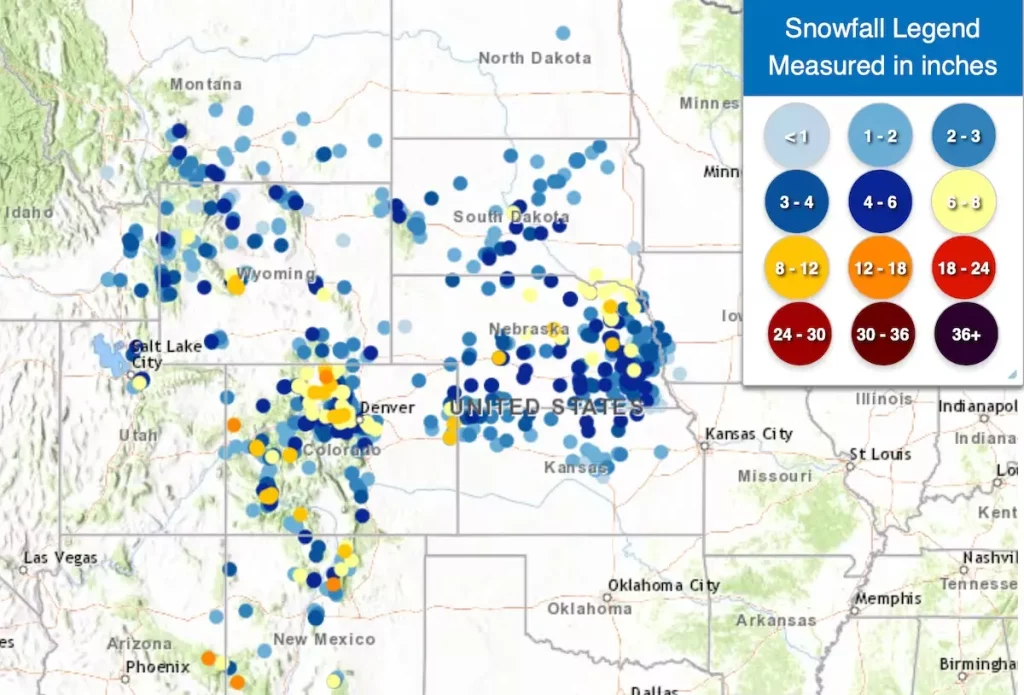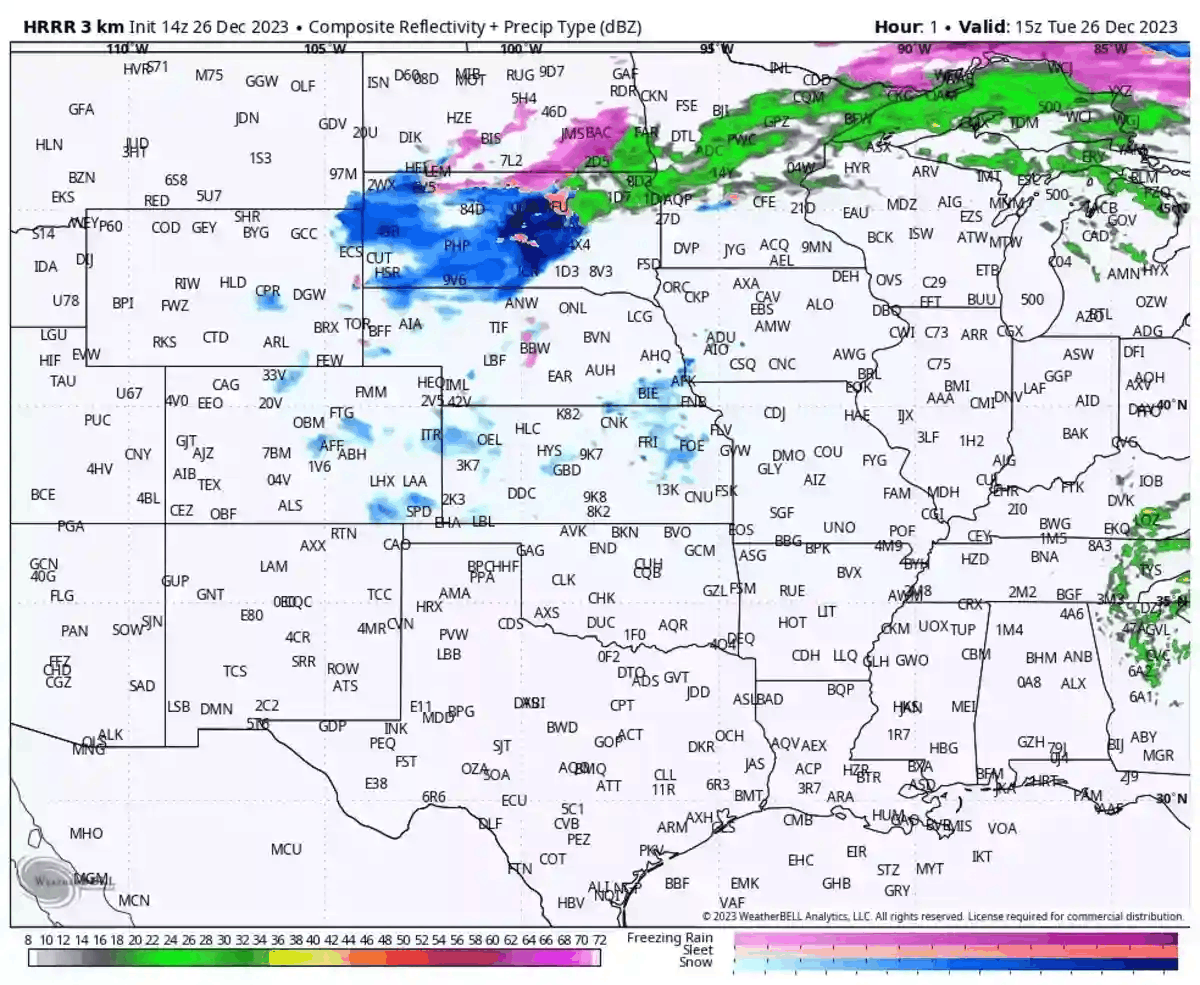A powerful winter storm is battering the northern Plains, dumping heavy snow, coating roads with ice and whipping up strong winds that reduce visibility and cause whiteout conditions. The storm is disrupting travel plans for many Americans who are trying to return home after the Christmas holiday, as nearly a third of them are expected to travel at least 50 miles.
If you want to learn how your actions can make a difference for our planet, sign up for the Climate Coach newsletter, delivered to your inbox every Tuesday and Thursday. The National Weather Service has issued blizzard warnings for parts of northeast Colorado, northwest Kansas and South Dakota. Ice storm warnings are also in effect for eastern North Dakota, where rain is freezing on contact with the cold surface.
The weather service cautioned that travel could be very difficult, as blowing snow could significantly reduce visibility and gusty winds could bring down tree branches.
The storm will not ease up even after the snow stops falling, as the strong winds will continue to blow around the fresh snow and create ground blizzard conditions, which are equally hazardous.
Some major highways have been closed due to the storm, such as Interstate 90 in South Dakota between Mitchell (exit 332) and Wall (exit 110), and Interstate 94 in North Dakota between Hebron and west of Fargo.

The storm will persist until early Wednesday in some areas before it gradually weakens.
The storm originated from the Four Corners region, where it brought snow to the high elevations of New Mexico and Arizona before moving eastward behind the Rockies. The storm then intensified as it drew moisture from the air and spun counterclockwise. The moisture collided with the cold air behind the storm and produced heavy snowfall in the mountains of Colorado. The storm then moved northeastward and spread its impact across the northern Plains.
Snowfall totals from the storm
Here’s a roundup of some of the biggest totals thus far:
- 14 inches in Mogollan, N.M.
- 13 inches in Douglas Pass, Colo.
- 13 inches in Sunrise Park, Ariz.
- 12.8 inches in Glendevey, Colo.
- 11.4 inches in Lander, Wyo.
- 10.5 inches in Aspen Springs, Colo.
- 10 inches in Wolf Creek Pass, Colo.
- 8.8 inches in Lawson, Colo.
- 8.5 inches Burwell, Neb.
- 8 inches in McLean, Neb.
- 7 inches in Norfolk, Neb.
- 6.5 inches in Fort Pierre, S.D.
- 6 inches in Tyndall, S.D.
- 4.1 inches in Gann Valley, S.D.

Why the storm is so impactful despite modest snowfall
The snowfall amounts over the Plains are not very impressive, and are actually quite normal for this time of year. So what makes this storm so disruptive? The answer is the wind. The wind is blowing strongly across the northern Plains and the Front Range, creating drifts and blowing snow. Some places have recorded wind gusts over 60 mph, such as Sterling, Colo., along Interstate 76, and the Denver International Airport. Sidney, Neb., also gusted to 60 mph, and many other locations had gusts between 45 and 55 mph. Rapid City, S.D., even gusted to 73 mph, which is almost as strong as a hurricane.
The storm is caused by a low pressure system that was centered in central Nebraska, and then slowly moved southeastward. This means that the precipitation will become lighter and less widespread; the low should reach Kansas City, Mo., by evening, and move toward Paducah, Ky., by Wednesday afternoon.
The wind will also calm down gradually, with gusts of 40 mph or more confined to the High Plains from the Nebraska Sandhills and eastern Colorado to the Texas and Oklahoma panhandles by Tuesday night. Only a few isolated gusts of 35 mph or more are expected in the Nebraska Sandhills on Wednesday. That’s why the blizzard warnings will expire soon.
Icy conditions in eastern North Dakota
In eastern North Dakota, a thin layer of warm and moist air was pulled northward on the eastern side of the low. This created a problem, because the air near the ground was cold, dense and below freezing. This means that the rain that fell from the warm air froze when it touched the ground, turning the landscape into a slippery mess.
By Christmas evening, some places had a quarter-inch of ice on the ground, such as Rustad and Wahpeton in North Dakota, and Moorhead and Muskoda in Minnesota. Fargo, N.D., had even more, with 0.4 inches of ice. A half-inch of ice is enough to cause power outages and damage trees, but fortunately, there were not many reports of such problems.
The Aberdeen Regional Airport in South Dakota also had 0.25 inches of ice on the ground as of Tuesday morning.





